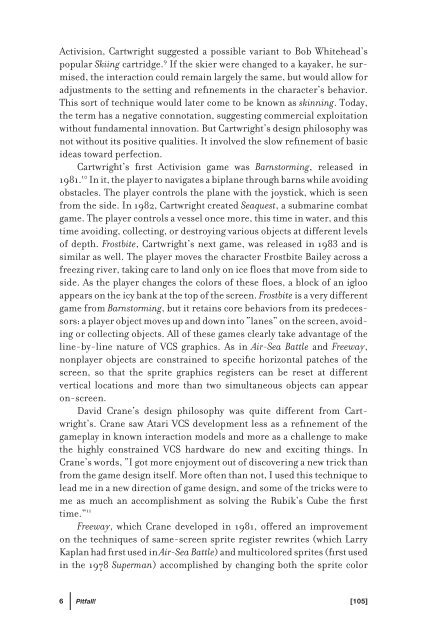Racing the Beam : the Atari Video Computer System - Index of
Racing the Beam : the Atari Video Computer System - Index of
Racing the Beam : the Atari Video Computer System - Index of
Create successful ePaper yourself
Turn your PDF publications into a flip-book with our unique Google optimized e-Paper software.
Activision, Cartwright suggested a possible variant to Bob Whitehead’s<br />
popular Skiing cartridge. 9 If <strong>the</strong> skier were changed to a kayaker, he surmised,<br />
<strong>the</strong> interaction could remain largely <strong>the</strong> same, but would allow for<br />
adjustments to <strong>the</strong> setting and refi nements in <strong>the</strong> character’s behavior.<br />
This sort <strong>of</strong> technique would later come to be known as skinning. Today,<br />
<strong>the</strong> term has a negative connotation, suggesting commercial exploitation<br />
without fundamental innovation. But Cartwright’s design philosophy was<br />
not without its positive qualities. It involved <strong>the</strong> slow refi nement <strong>of</strong> basic<br />
ideas toward perfection.<br />
Cartwright’s fi rst Activision game was Barnstorming, released in<br />
1981. 10 In it, <strong>the</strong> player to navigates a biplane through barns while avoiding<br />
obstacles. The player controls <strong>the</strong> plane with <strong>the</strong> joystick, which is seen<br />
from <strong>the</strong> side. In 1982, Cartwright created Seaquest, a submarine combat<br />
game. The player controls a vessel once more, this time in water, and this<br />
time avoiding, collecting, or destroying various objects at different levels<br />
<strong>of</strong> depth. Frostbite, Cartwright’s next game, was released in 1983 and is<br />
similar as well. The player moves <strong>the</strong> character Frostbite Bailey across a<br />
freezing river, taking care to land only on ice fl oes that move from side to<br />
side. As <strong>the</strong> player changes <strong>the</strong> colors <strong>of</strong> <strong>the</strong>se fl oes, a block <strong>of</strong> an igloo<br />
appears on <strong>the</strong> icy bank at <strong>the</strong> top <strong>of</strong> <strong>the</strong> screen. Frostbite is a very different<br />
game from Barnstorming, but it retains core behaviors from its predecessors:<br />
a player object moves up and down into “lanes” on <strong>the</strong> screen, avoiding<br />
or collecting objects. All <strong>of</strong> <strong>the</strong>se games clearly take advantage <strong>of</strong> <strong>the</strong><br />
line-by-line nature <strong>of</strong> VCS graphics. As in Air-Sea Battle and Freeway,<br />
nonplayer objects are constrained to specifi c horizontal patches <strong>of</strong> <strong>the</strong><br />
screen, so that <strong>the</strong> sprite graphics registers can be reset at different<br />
vertical locations and more than two simultaneous objects can appear<br />
on-screen.<br />
David Crane’s design philosophy was quite different from Cartwright’s.<br />
Crane saw <strong>Atari</strong> VCS development less as a refi nement <strong>of</strong> <strong>the</strong><br />
gameplay in known interaction models and more as a challenge to make<br />
<strong>the</strong> highly constrained VCS hardware do new and exciting things. In<br />
Crane’s words, “I got more enjoyment out <strong>of</strong> discovering a new trick than<br />
from <strong>the</strong> game design itself. More <strong>of</strong>ten than not, I used this technique to<br />
lead me in a new direction <strong>of</strong> game design, and some <strong>of</strong> <strong>the</strong> tricks were to<br />
me as much an accomplishment as solving <strong>the</strong> Rubik’s Cube <strong>the</strong> fi rst<br />
time.” 11<br />
Freeway, which Crane developed in 1981, <strong>of</strong>fered an improvement<br />
on <strong>the</strong> techniques <strong>of</strong> same-screen sprite register rewrites (which Larry<br />
Kaplan had fi rst used in Air-Sea Battle) and multicolored sprites (fi rst used<br />
in <strong>the</strong> 1978 Superman) accomplished by changing both <strong>the</strong> sprite color<br />
6 Pitfall! [105]


